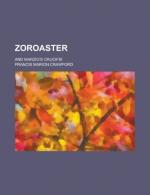At the extremities of the long bench huge iron vices were fixed by staples that ran into the ground. In one of these was fastened the long curved tool which serves to beat out the bosses of hollow and small-necked vessels. Each of the workmen had a pedal beneath his foot from which a soft cord ascended, passed through the table, and pressed the round object on which he was working upon a thick leather cushion, enabling him to hold it tightly in its place, or by lifting his foot to turn it to a new position. In pots full of sand were stuck hundreds of tiny chisels, so that the workmen could select at a glance the exact form of tool needful for the moment. Two or three half balls of heavy stone stood in leathern collars, their flat surfaces upwards and covered with a brown composition of pitch and beeswax an inch thick, in which small pieces of silver were firmly embedded in position to be chiselled.
The workshop was pervaded by a smell of wax and pitch, mingled with the curious indefinable odour exhaled from steel tools in constant use, and supplemented by the fumes of Marzio’s pipe. The red bricks in the portion of the floor where the two men sat were rubbed into hollows, but the dust had been allowed to accumulate freely in the rest of the room, and the dark corners were full of cobwebs which had all the air of being inhabited by spiders of formidable dimensions.
Marzio Pandolfi, who bent over his work and busily plied his little hammer during the interval of silence which followed his apprentice’s last remark, was the sole owner and master of the establishment. He was forty years of age, thin and dark. His black hair was turning grey at the temples, and though not long, hung forward over his knitted eyebrows in disorderly locks. He had a strange face. His head, broad enough at the level of the eyes, rose to a high prominence towards the back, while his forehead, which projected forward at the heavy brows, sloped backwards in the direction of the summit. The large black eyes were deep and hollow, and there were broad rings of dark colour around them, so that they seemed strangely thrown into relief above the sunken, colourless cheeks. Marzio’s nose was long and pointed, very straight, and descending so suddenly from the forehead as to make an angle with the latter the reverse of the one most common in human faces. Seen in profile, the brows formed the most prominent point, and the line of the head ran back above, while the line of the nose fell inward from the perpendicular down to the small curved nostrils. The short black moustache was thick enough to hide the lips, though deep furrows surrounded the mouth and terminated in a very prominent but pointed chin. The whole face expressed unusual qualities and defects; the gifts of the artist, the tenacity of the workman and the small astuteness of the plebeian were mingled with an appearance of something which was not precisely ideality, but which might easily be fanaticism.




